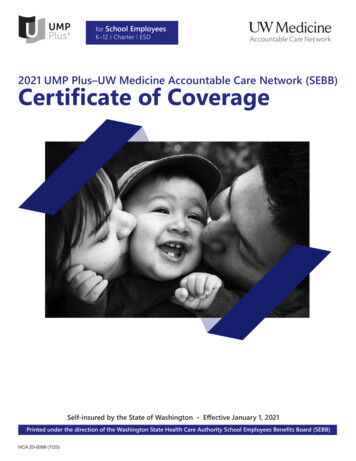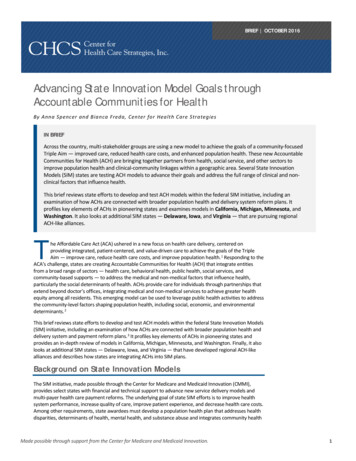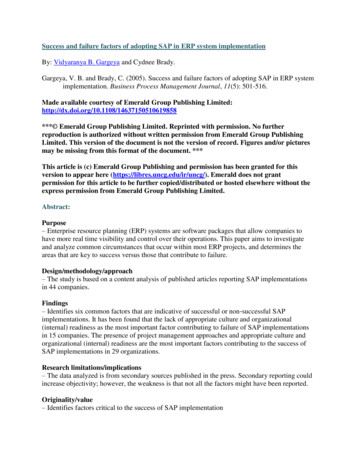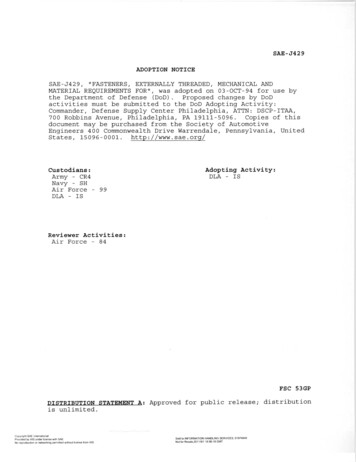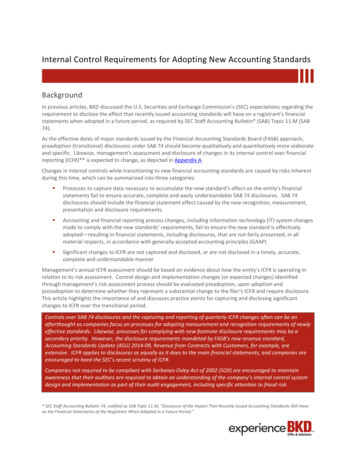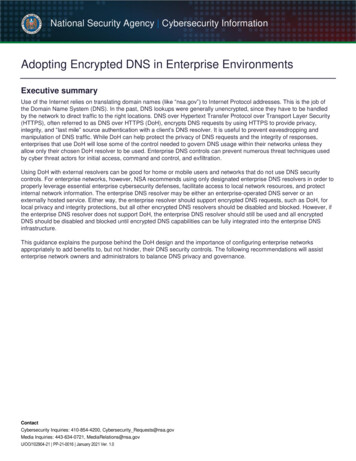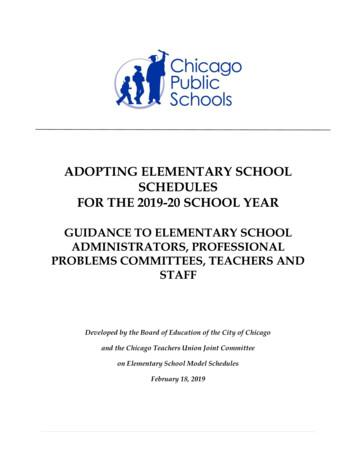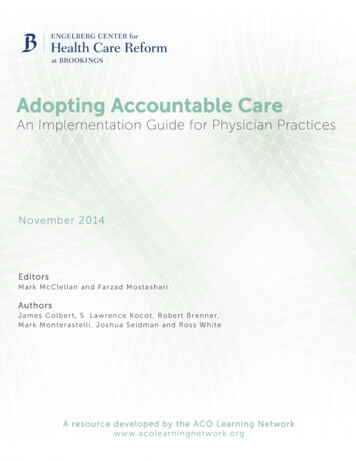
Transcription
Adopting Accountable CareAn Implementation Guide for Physician PracticesNovember 2014EditorsMark McClellan and Farzad MostashariAuthorsJames Colbert, S. Lawrence Kocot, Robert Brenner,Mark Monterastelli, Joshua Seidman and Ross WhiteA resource developed by the ACO Learning Networkwww.acolearningnetwork.org
Adopting Accountable Care: An Implementation Guide for Physician PracticesTABLE OF CONTENTSAUTHORS . 3ACKNOWLEDGMENTS 4EXECUTIVE SUMMARY . 5Part 1INTRODUCTIONPhysician Practices and Their Critical Rolein the Accountable Care Movement . 10CHAPTER 1Identifying and Managing High-Risk Patients 13CHAPTER 2Developing High Value Referral Networks . 25CHAPTER 3Using Event Notifications .33CHAPTER 4Engaging Patients . 42Part 2CASE STUDIES IN ACCOUNTABLE CARE 52APPENDICESAppendix A: Sample ACO Annual Operating Budget . 58Appendix B: Helpful Links and Resources . 59Appendix C: Glossary of Key Terms .61ENDNOTES . . 652
Adopting Accountable Care: An Implementation Guide for Physician PracticesAuthorsEditorsMark McClellanDirector, Health Care Innovation and Value InitiativeSenior Fellow, The Brookings InstitutionFarzad MostashariChief Executive OfficerAledadeAuthorsJames ColbertConsultant, ACO Learning NetworkPhysician, Newton-Wellesley HospitalInstructor in Medicine, Harvard Medical SchoolRobert BrennerChief Medical OfficerSummit Medical GroupS. Lawrence KocotVisiting Fellow, Economic StudiesThe Brookings InstitutionMark MontarastelliEntrepreneur in Residence, Office of the NationalCoordinator for Health ITRoss WhiteSenior Project ManagerEngelberg Center for Health Care ReformThe Brookings InstitutionJoshua SeidmanVice PresidentCenter for Payment & Delivery InnovationAvalereAbout the Engelberg Center for Health Care Reform at BrookingsEstablished in 2007, the Engelberg Center for Health Care Reform at Brookings is dedicated to providingpractical solutions to achieve high-quality, innovative, affordable health care. To achieve its mission, theCenter conducts research, develops policy recommendations, and provides technical expertise to test andevaluate innovative health care solutions.3
Adopting Accountable Care: An Implementation Guide for Physician PracticesAcknowledgementsThe authors acknowledge the support of the following individuals for their contributions and insights:Chapter 1: Craig Behm (MedChi Network Services), Sumir Sahgal (Balance ACO), Karen Cabell (Billings Clinic),Sharon Fay and Lauri Rustand (Health Connect), Larry Jones (Physicians Collaborative Trust), Jamie Reedy(Summit Medical Group), Scott Hines, Jonathan Nasser (Crystal Run Healthcare), Clemens Hong(Massachusetts General Hospital), Suchi Saria (Johns Hopkins), Lindsey Haas (Mayo Clinic), Benjamin Berk(Iora Health), Stacey Counts (Heartland Regional Medical Center), Jeffrey Brenner (Camden Coalition), KarenJoynt (Harvard School of Public Health)Chapter 2: Mitch Schwartz and Tom Pianta (Anne Arundel Medical Center), Curtis Page and LanceDonkerbrook (Commonwealth ACO), Helene Kopal and Neil Calman (Family Health ACO), Craig Behm(MedChi), Deb Rogers (Optimus), Larry Jones (Physician’s Collaborative Trust), Jeff Butler, Graham Galka andAndy Aronson (Privia Health), Gregory Reicks (Mesa IPA), Fred Trotter (DocGraph), Kelsey Mellard(NaviHealth), Dana Safran (BCBSMA), Neil Kurtz and John Perticone (Golden Living), Neil Kirschner (AmericanCollege of Physicians)Chapter 3: Craig Behm (MedChi), Sumir Sahgal (Balance ACO), Tom Pianta and Mitch Schwartz (Anne ArundelMedical Center), Larry Garber (Reliant Medical Group), Scott Afzal (Audacious Inquiry), Jay Desai (PatientPing), Kent Hiller, Curt Sellke, and Rachel Underwood (Indiana Health Information Exchange), Matt Koerlinand Gene Boerger (Emdeon)Chapter 4: Scott Hines and Jonathan Nasser (Crystal Run), Helene Kopal and Neil Calman (Family Health ACO),Lauri Rustand, Sharon Fay, and John Loomis (Health Connect ACO), Kelly Conroy and Hymin Zucker (PalmBeach ACO), Jeff Butler, Graham Galka and Andy Aronson (Privia), Rob Brenner (Summit Medical Group);Jeffrey Kullgren (University of Michigan), Judith Hibbard (University of Oregon), Sally Okun (Patients Like Me),Scott Halpern (U Penn).Additional thanks to: Asaf Bitton (Brigham and Women’s Hospital), Namita Mohta (Partners Healthcare),Amy Boutwell (Collaborative Healthcare Strategies), Corbin Petro (ElevateHealth), Karen Joynt (HarvardSchool of Public Health), Jen Regan, Peter Grape, and Elinor Sablone (Harbor Medical Associates), DianeCardwell and Terry McGeeney (VillageMD), Marci Nielsen (PCPCC), Jeffrey Greenberg (Brigham and Women’sHospital), Clay Ackerly (Massachusetts General Hospital), Christine Bechtel (Bechtel Health Advisory Group),Staff at Ariadne Labs.The authors also thank all of the organizations that took part in the ACO Learning Network InnovationExchange on physician-led ACOs. This toolkit would not have been completed without their perspectives,insights, and tireless efforts to advance accountable care: Anne Arundel Medical Center, Balance ACO, BillingsClinic, Commonwealth Primary Care ACO, Crystal Run Healthcare, CSMS-IPA, Family Health ACO, HealthConnect ACO, MedChi Network Services, New West Physicians, Optimus Healthcare Partners, Palm BeachACO, Physicians Collaborative Trust, LLC, Privia Quality Network, Renal Physicians of Georgia, Summit MedicalGroup.The authors also thank Michelle Shaljian, Marcela Cabello, Pratyusha Katikaneni and Anna Marcus for theirresearch and editorial support.4
Adopting Accountable Care: An Implementation Guide for Physician PracticesExecutive SummaryEarly results from the Medicare Shared SavingsProgram (MSSP) suggest that physician-led ACOsmay actually have a leg up in terms of accountablecare success. Out of the 49 MSSP participants thatqualified for shared savings in their firstperformance year, a higher rate of physician-ledACOs earned shared savings compared to nonphysician-led ACOs. While results are still beinganalyzed, these findings suggest that physician-ledACOs can play an important role in driving healthcare reform.Our nation’s health care system continues toundergo significant transformation to address thequality and high cost of care. Accountable CareOrganizations (ACOs) have become a substantialpart of these efforts by realigning our currentpayment system to reward organizations thatachieve high-value care. While the ACO conceptcontinues to evolve, it can broadly be defined as:“a group of health care providers who acceptshared accountability for the cost and quality ofcare delivered to a population of patients.”Physician-led provider organizations are quicklybecoming one of the biggest drivers ofaccountable care activity. Typically, these groupsare not hospital affiliated and instead include oneor more independent primary care physiciangroups or practice associations that have a largecombined patient population. The physicianmembers of these ACOs lean heavily towardprimary care, but are increasingly includingspecialists. Unlike hospital-led ACOs which mayoffer primary care, specialty care, and acute careto their patients, many physician-led ACOs arelimited to providing primary care, yet maintainresponsibility for the total cost of each patient’scare.The purpose of this toolkit is to focus on theunique challenges and opportunities for physicianled ACOs. This work builds on the original ACOToolkit developed by the ACO Learning Networkin 2011 to help ACOs address technical,operational, and legal issues in ACO developmentand implementation. Likewise, the goal of thistoolkit is to provide emerging physician-led ACOswith the knowledge and tools necessary toeffectively address four critical issues inaccountablecaredevelopmentandimplementation: (1) identifying and managinghigh-risk patients; (2) developing high-valuereferral networks, (3) using event notifications,and (4) engaging patients.These physician-led ACOs can play an integral rolein improving primary care and delivering highquality care coordination. Together these effortshave been effective in improving patientoutcomes, reducing unnecessary hospitalizationsand emergency room visits, and lowering costs.Successful population health management inthese ACOs typically results in the provision ofmore primary care services (low cost care) andless acute care services (high cost care) inhospitals and other settings.This toolkit is a result of a collaborative effort bymembers of the ACO Learning ce calls and shared innovative ideas,technical challenges and lessons with each other.We also invited a number of guest experts tocontribute their thoughts and ideas to inform thedevelopment of this resource. The toolkit includesexamples and case studies to illustrate howvarious ACOs are approaching the implementationchallenges they face in delivering high-value care.This executive summary provides key takeawaysand recommendations from each chapter of thetoolkit. While all lessons may not apply to allphysician-led ACOs, they should serve as a guideor checklist of competencies that can preparethese organizations for success.Because physician-led ACOs are often smallerorganizations, they tend to be more flexible andnimble when it comes to adopting new practicesand clinical transformation. However, these ACOsmay have less advanced health IT systems, fewerresources and capital to invest in clinical andorganizationaltransformation,andlessexperience with risk-based contracts.5
Adopting Accountable Care: An Implementation Guide for Physician Practices3. Combine your raw analytics with clinicalintuition. Providers have insights about theirpatients that cannot be ascertained by mostanalytic models. This includes gauging whichpatients do not show up for appointments, livealone, are unsteady on their feet, or have otherpsychosocial comorbidities. We recommendgiving providers a list of patients generatedelectronically, and have them review the listbased on their own knowledge of the patients.CHAPTER 1Identifying and Managing High-RiskPatientsA cornerstone of successful accountable care is toidentify patients who are not receiving optimalcare, are overutilizing health resources, and as aresult are contributing to excessive spending. Byidentifying those patients who are not currentlywell served by the health system and providingadditional targeted resources (i.e., carecoordination,socialservices,orcaremanagement), there is an opportunity to improvepopulation health and achieve significantreductions in total spending.This chapterprovides an overview of approaches to identifyhigh-risk patients and strategies for implementingeffective care management.4. Take advantage of patient-reported data. Byasking patients to share personal information withtheir providers about their health care goals anddisease-management challenges, a wealth ofuseful information can be obtained. ACOs can useestablished metrics such as the Patient ActivationMeasure (PAM), or they can create their ownpatient measures to track.A. Identifying High-Risk PatientsB. Care Management1. Define an intervention. A key step isdetermining how you will intervene in the care ofpatients identified through a risk stratificationprocess. If your goal is to perform intensive caremanagement on the patients most likely to beadmitted to the hospital for poorly managedchronic conditions, then analytics should betailored to identify this population. If you hope tion process should be set up to flagthese patients. This process can help determinethe most promising care management tools foryour ACO, and select the patients most likely tobenefit.1. Invest in coordinated care transitions.Creating a standardized workflow for smooth caretransitions is essential to reducing hospitalreadmissions and can significantly reduce costs.Success of such a program will rely on the abilityto receive notifications of patient discharges fromhospitals and post-acute care facilities. Providersalso benefit from a daily workflow that ensurespatients are contacted within 1-2 days ofdischarge, medications are reconciled, referralsare tracked and patient education is completed.2. Use intensive care management thoughtfully.Think carefully about how to select patients forintensive care management. Data show that suchprograms can have dramatic success, but they arealso costly. Care managers are precious resourcesand must be deployed in such a way as tomaximize their impact on the patients theymanage. Choosing patients who already havestrong support networks and dedicated caregiversmay prevent you from realizing significantbenefits from your intervention and from reachingthe patients who need care management themost.2. Use analytics tools that are most accessible.If your population health vendor has set up anintegrated predictive modeling platform thatintegrates all of your claims and EHR data, thenuse that tool. Look elsewhere if you don’t havesuch a tool at your disposal or your vendor hasover-promised and the integration is runningbehind schedule. Start with the data you haveavailable and use a free risk-stratification methodsuch as Hierarchical Condition Categories (HCC),Charlson, or the Chronic Condition Count. You cansimplify efforts by creating a list of patients withmultiple hospital admissions over the past sixmonths.3. Set up your care management to promotemeaningful relationships. Position your caremanagers such that they are able to developrelationships with the patients they are managing.6
Adopting Accountable Care: An Implementation Guide for Physician PracticesIf their offices are embedded within a primarycare practice, they can meet with patients duringan already scheduled visit, and they can buildstrong relationships with primary care providers.If embedded care managers are not practical foryour organization, consider having care managersconduct home visits, hospital visits or even postacute facility visits. The stronger the bondbetween care manager and patient, the morelikely the patient will be to contact the caremanager when medical needs arise.which providers outside of the ACO are caring foryour ACO’s patients? These data can be obtainedthrough chart reviews, clinician surveys, claimsanalysis, or public use datasets. Once established,this information can inform more activemanagement of referrals and improve carecoordination.2. Reduce unnecessary referrals. There is widevariation among primary care physicians regardinghow often patients are referred to specialists. In afee-for-service model there is no financialincentive to think twice before sending a patientto see a specialist for even minor medical issues.Sharing individual referral variation data withprimary care physicians and establishing careprotocols for common conditions can help reducereferrals for conditions that can be managedequally well by a primary care practice. Primarycare physicians can also obtain the training tomanage certain conditions that are often referredto specialists, including simple skin biopsies,diabetes or heart disease.4. Use information technology to promote caremanagement success. Very few electronic healthrecord (EHR) systems are equipped to integratecare management. However, without ITintegration, the hard work of a care manager maynever result in meaningful impact. Consult with ITstaff to develop a communication system thatallows care managers to coordinate with otherhealth providers including primary care,hospitalists, ED physicians, home health nurses,and others. If a patient is part of a caremanagement program, this should be prominentlydisplayed in the record to flag as a high-riskpatient.3. Improve care coordination between primarycare and specialists. Inefficiencies in the healthcare system, such as lack of EHR interoperability,mean that a primary care physician often cannotreceive information about a specialist referralunless the document is faxed. Similarly, specialistsmay not be aware of prior tests or diagnoses priorto the visit. As a result, many patients receiveduplicate tests and other unnecessary services.Implementing the medical home neighbor modelcan help provide a framework for improvedcoordination of care and increased efficiency.Elements of this model include greements, and shared expectations regardingcommunication between providers.CHAPTER 2Developing a High-Value ReferralNetworkPrimary care services represent only 6 to 7percent of total health care spending for any givenpatient, yet primary care physicians indirectlycontrol or influence a much larger percentage ofhealth care spending through decisions regardingreferrals, diagnostic testing, home health care,and other ancillary health services. Physician-ledACOs will need to work beyond their own ACO toimpact care throughout the care continuum,including specialty, inpatient, and post-acute care.This chapter describes strategies to improverelationships with clinical providers outside ofyour ACO.4. Avoid unnecessary facility fees. Medicarereimbursement rates for a screening colonoscopyor lumbar spine MRI are significantly higher in ahospital setting. Identifying imaging centers andendoscopy centers that are not affiliated withhospitals and do not charge a facility fee couldfacilitate significant cost savings.1. Understand existing referral patterns. The firststep in crafting a high-value referral network is tounderstand the current referral patterns of yourACO providers and how your ACO patients areutilizing resources. For example, do you know5. Identify and partner with cost-effectivespecialists and other providers.While7
Adopting Accountable Care: An Implementation Guide for Physician Practiceschallenging, identifying cost-effective providerscan be achieved with the help of a robust analyticsteam who can gauge utilization and adherence toclinical guidelines by looking at claims data. If suchanalysis is beyond the capability of your practice,another option is to consult with primary carephysicians. Finally, if your ACO has the potential todrive a significant amount of volume to preferredspecialists, a preferred partnership may providean incentive for the specialist to coordinate care,and to practice more cost-effectively withoutcompromising quality of care.strategies and highlights examples of ACOs thatare using technology to improve carecoordination.1. Get your data house in order. An advantagefor many physician-led ACOs is having readyaccess to clinical data. Ensuring that you aremaking meaningful use of existing EHRs willprovide the necessary foundation from which youcan pull key elements of population health.Fundamental information about patient problems,medications, tests, demographics and vital signsare the building blocks from which all other datafeeds can expand. Creating master patient indexeswith care team relationships defined is alsonecessary.6. Bring specialists into your ACO. A furtherstrategy to control costs is to integrate specialistswithin your ACO and enable them to beaccountable with you for the cost and quality ofcare. They will be able to participate in sharedsavings and may undertake stronger collaborationwith primary care physicians. For high-demandspecialists such as cardiology, psychiatry,dermatology and endocrinology, the specialistcould be embedded within the primary carepractice itself.2. Leverageexistingrelationships.Takeadvantage of state-wide or regional healthinformation exchange (HIE) capabilities wherethey exist. However, if sufficient HIE infrastructuredoes n
Exchange on physician-led ACOs. This toolkit would not have been completed without their perspectives, . LLC, Privia Quality Network, Renal Physicians o
